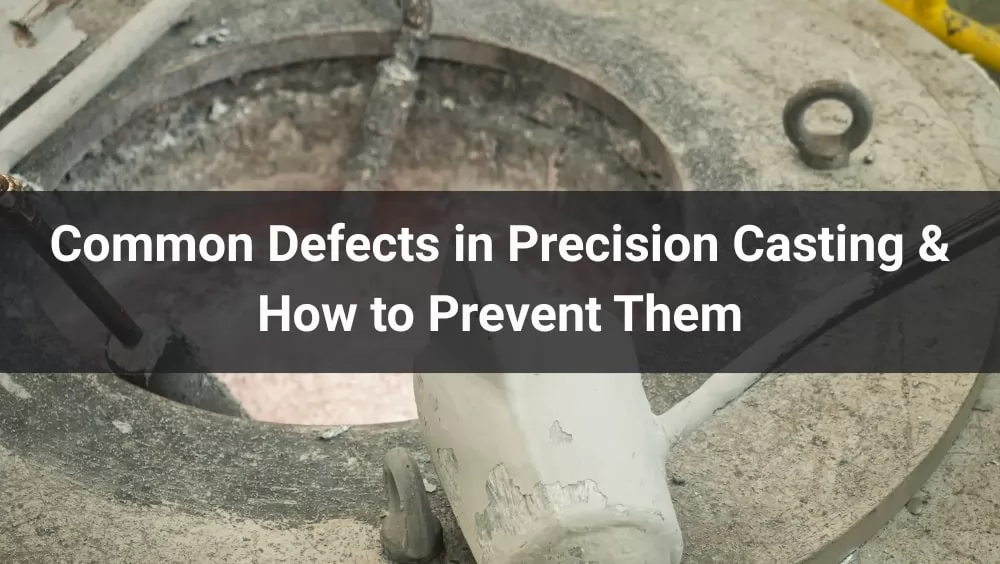
Even in high-precision casting, defects like shrinkage, porosity, or cracks can occur—often due to early-stage errors. Understanding these issues is key to improving quality and reducing waste.
In this guide, we’ll explore the most common defects in precision casting, why they happen, and how to prevent them effectively in your workflow.
Table of Contents
- What Are Casting Defects?
- Top 10 Common Defects in Precision Casting
- Root Causes: Why Do These Defects Occur?
- How to Prevent Casting Defects
- FAQs About Precision Casting Defects
- Conclusion: Precision Without Compromise
What Are Casting Defects?
Definition: Casting defects are irregularities in the final product that deviate from design or quality standards. These can affect appearance, functionality, or safety.
Types of Defects:
Surface vs. Internal: Surface defects are visible, while internal ones may require imaging or testing.
Minor vs. Critical: Some defects are tolerable, while others demand part rejection or rework.
| Defect Type | Visibility | Impact Level | Root Cause Example |
|---|---|---|---|
| Shrinkage Cavity | Internal | High | Poor metal feeding |
| Gas Porosity | Internal | Medium | Entrapped gases in the mold |
| Cracks | Surface | High | Thermal stress or improper cooling |
Top 10 Common Defects in Precision Casting
| Defect | Description |
|---|---|
| Shrinkage Cavity | Voids from metal shrinkage during cooling. |
| Porosity | Gas trapped causing bubbles inside. |
| Cracks | Thermal stress cracks during or after cooling. |
| Misruns & Cold Shuts | Incomplete mold filling or fusion failure. |
| Inclusions | Non-metal particles in casting. |
| Flash | Excess metal leaks at mold joints. |
| Warping | Part distortion from uneven cooling. |
| Surface Roughness | Poor surface from mold finish or contamination. |
| Mold Cracking | Ceramic mold cracks from thermal shock. |
| Dimensional Inaccuracy | Parts out of spec due to mold shift. |
1. Shrinkage Cavity
Shrinkage cavities occur when molten metal contracts during solidification, leaving internal voids that weaken the casting.
Solution: Improve feeding system design, use risers and chills for controlled cooling.
Prevention: Optimize mold design for uniform cooling and maintain proper metal temperature.
2. Porosity (Gas Holes)
Porosity is caused by gas trapped in molten metal or mold, resulting in bubbles inside the casting.
Solution: Use degassing techniques and preheat molds to reduce moisture.
Prevention: Ensure molds are dry and control pouring speed to avoid turbulence.
3. Cracks (Hot and Cold)
Hot cracks form during solidification from thermal stresses; cold cracks occur after cooling due to brittleness or residual stress.
Solution: Adjust alloy composition, control cooling rates, and avoid abrupt temperature changes.
Prevention: Use uniform cooling and proper heat treatments post-casting.
4. Misruns and Cold Shuts
Misruns happen when molten metal does not fully fill the mold; cold shuts occur when two metal streams fail to fuse.
Solution: Increase pouring temperature/speed and improve gating system design.
Prevention: Design molds with proper venting and gating to avoid incomplete fills.
5. Inclusions
Non-metallic particles like sand or slag become embedded in the casting, weakening it.
Solution: Filter molten metal and maintain clean molds.
Prevention: Use high-quality materials and clean foundry environment.
6. Flash or Burrs
Flash forms when metal leaks between mold sections, creating unwanted thin metal sheets.
Solution: Repair mold parting surfaces and adjust clamping pressure.
Prevention: Regular mold maintenance and precise machining.
7. Deformation / Warping
Uneven cooling or handling stresses cause parts to bend or warp.
Solution: Apply uniform cooling and support parts during cooling/handling.
Prevention: Design molds with consistent wall thickness and controlled cooling.
8. Surface Roughness or Pitting
Rough or pitted surfaces result from poor mold finish or contamination.
Solution: Improve mold finishing and apply refractory coatings.
Prevention: Use quality mold materials and maintain cleanliness.
9. Mold Cracking or Erosion
Ceramic molds may crack or erode during dewaxing or pouring due to thermal shock.
Solution: Preheat molds gradually and use high-quality refractory materials.
Prevention: Follow proper dewaxing and preheating procedures.
10. Dimensional Inaccuracy
Parts deviate from specifications due to mold shifting, thermal expansion, or poor alignment.
Solution: Ensure precise mold assembly and stable materials.
Prevention: Use accurate tooling and control temperature and pressure during casting.
Root Causes: Why Do These Defects Occur?

Many casting defects trace back to issues in the early stages of the precision casting process. Poor wax pattern quality, such as uneven thickness or dimensional inaccuracies, can lead to defects in the final product. Inconsistent replication of wax models results in irregularities that carry through to the ceramic mold and final casting.
Inadequate ceramic coating or improper drying during the shell building phase can weaken the mold, causing cracks or erosion when exposed to molten metal. If the ceramic layers are too thin, uneven, or contain moisture, the mold’s integrity is compromised, leading to defects.
Uncontrolled dewaxing temperature is another critical factor. If the temperature is too high or applied too quickly, thermal shock can crack the ceramic shell. Conversely, insufficient dewaxing may leave wax residues, affecting mold quality.
Incorrect pouring temperature and speed affect metal flow and solidification. Pouring metal that is too cold or too hot, or at a turbulent pace, can cause misruns, cold shuts, or porosity. Precise control is essential to fill molds completely without defects.
Contaminated or improperly prepared metal can introduce non-metallic inclusions, gas porosity, and weaken the casting. Metal must be clean, properly alloyed, and degassed before pouring to ensure quality.
Environmental factors such as dust, humidity, and temperature variations in the foundry can also contribute to defects. These external conditions impact mold drying, wax pattern storage, and metal handling, making strict environmental control important.
Tip: Most defects originate before metal pouring, so focusing on quality control during pattern making, mold building, and environmental management is crucial for defect-free castings.
How to Prevent Casting Defects

Preventing casting defects starts with ensuring high-quality wax patterns and carefully controlled ceramic shell building. Consistent inspection during these early stages, along with proper drying, helps create robust molds that resist cracking and erosion.
Next, focus on the dewaxing and metal pouring phases. Dewaxing should involve gradual temperature changes to avoid thermal shock. Proper pouring temperature and flow rate are equally essential to reduce porosity, misruns, and cold shuts.
Finally, maintaining a clean working environment and training staff regularly reduces contamination risks and improves process consistency. Implementing early inspections and feedback mechanisms further ensures fewer defects and better overall casting quality.
FAQs About Precision Casting Defects

Q1: What causes porosity in castings?
Porosity is usually caused by trapped gas. Use proper degassing and pour metal under vacuum or inert gas to prevent it.
Q2: Why do cast parts crack after cooling?
Cracks often result from uneven cooling or thermal stress. Control mold temperature and cool parts gradually.
Q3: How can I prevent shrinkage cavities?
Design proper feeders and risers to supply metal during solidification and avoid sharp changes in cross-section.
Q4: How are internal defects detected?
Use non-destructive tests like X-rays or ultrasonic inspection to spot hidden cracks or porosity.
Q5: Can casting defects be repaired?
Minor defects can be fixed by grinding or welding. Major internal defects often require recasting.
Conclusion: Precision Without Compromise
Most casting defects are preventable with better pattern control, shell building, temperature management, and clean conditions.
At Besser, we focus on every detail to minimize defects and deliver reliable, high-quality castings. Choose Besser for cast parts that meet your toughest demands.



